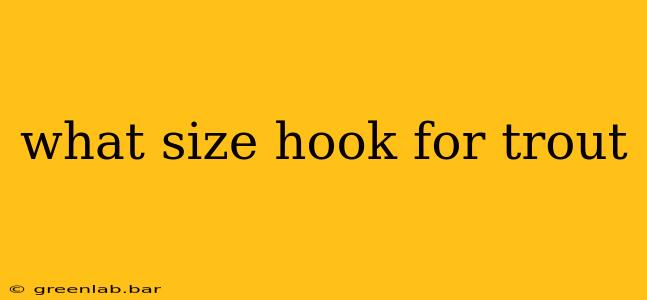Choosing the right hook size for trout fishing is crucial for success. Too large, and you'll scare them away; too small, and you risk losing your catch. This guide will break down the factors influencing hook size selection, helping you choose the perfect hook for your next trout fishing adventure.
Factors Affecting Hook Size Selection
Several key factors determine the appropriate hook size for trout fishing:
1. Trout Size & Species:
- Smaller Trout (under 10 inches): Size 14-18 hooks are generally ideal. Smaller hooks minimize damage and increase hookup rates. For delicate presentations like dry flies, even smaller sizes might be necessary.
- Medium Trout (10-16 inches): Size 10-14 hooks are a good starting point. This range offers a balance between hook strength and minimizing fish damage.
- Larger Trout (over 16 inches): Size 6-10 hooks are suitable for larger trout. Larger hooks provide the necessary strength to handle the power of a bigger fish.
Species-Specific Considerations: Some trout species are more aggressive than others. For aggressive feeders, you might opt for a slightly larger hook size.
2. Bait or Lure Type:
- Dry Flies: Sizes 18-24 are common for small dry flies, while larger flies might use sizes 10-14.
- Wet Flies & Nymphs: Sizes 12-18 are frequently used for nymphs and wet flies, but again, size will depend on the specific pattern and target fish size.
- Worms, Insects, and Baitfish: The hook size should be appropriate for the size of the bait. A small worm will require a smaller hook than a larger minnow.
- Spinners & Spoons: Hook sizes vary considerably depending on the lure size and design. Consult the manufacturer's recommendations.
- Artificial lures (crankbaits, etc.): These often come with pre-installed hooks, but you can swap them for different sizes if needed.
3. Fishing Conditions:
- Clear Water: Use smaller, lighter hooks that are less noticeable to fish.
- Murky Water: Visibility is reduced, allowing the use of slightly larger hooks without compromising hookup rates.
4. Hook Style:
The shape and design of the hook also matter. Different hook styles are designed for specific presentations and bait types. Some popular choices include:
- Barbless Hooks: These are becoming increasingly popular due to their ease of removal from fish, promoting catch and release practices. While they may have a slightly lower hook-up rate, the increased survival rate often outweighs this disadvantage.
- Standard Hooks: The classic hook design, offering reliable performance and availability.
- Wide Gap Hooks: These hooks are ideal for soft bait and provide a better hookset.
Choosing the Right Hook: A Step-by-Step Guide
- Identify your target trout size: Observe the size of trout in the area you're fishing or use information from local anglers.
- Select your bait or lure: The bait's size dictates the suitable hook size.
- Consider water clarity: Adjust the hook size accordingly.
- Choose a hook style: Select barbless or standard hooks based on your preference and fishing practices.
- Refer to manufacturer's recommendations: If using artificial lures, always check the manufacturer's recommendations for hook size.
Conclusion:
Selecting the appropriate hook size is a crucial aspect of successful trout fishing. By carefully considering the factors discussed above and following the steps outlined, you can significantly improve your chances of catching those elusive trout. Remember that experimentation and observation are key to finding what works best in different conditions and for various trout species.

